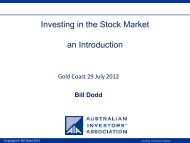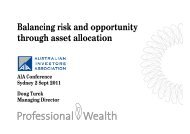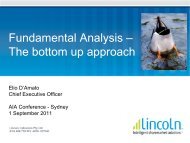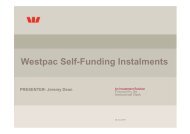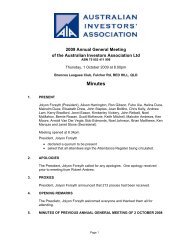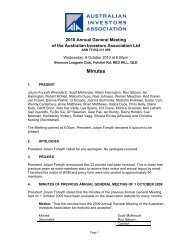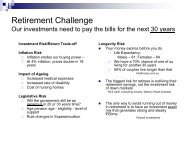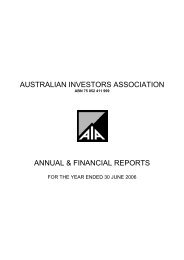reading a prospectus for unlisted debentures or unsecured notes
reading a prospectus for unlisted debentures or unsecured notes
reading a prospectus for unlisted debentures or unsecured notes
You also want an ePaper? Increase the reach of your titles
YUMPU automatically turns print PDFs into web optimized ePapers that Google loves.
INVESTING IN<br />
UNLISTED<br />
DEBENTURES AND<br />
UNSECURED<br />
NOTES?<br />
Independent guide <strong>f<strong>or</strong></strong> invest<strong>or</strong>s<br />
<strong>reading</strong> a <strong>prospectus</strong> <strong>f<strong>or</strong></strong> <strong>unlisted</strong><br />
<strong>debentures</strong> <strong>or</strong> <strong>unsecured</strong> <strong>notes</strong><br />
This guide is <strong>f<strong>or</strong></strong> you, whether you’re an<br />
experienced invest<strong>or</strong> <strong>or</strong> just starting out.
About ASIC<br />
The Australian Securities and Investments Commission (ASIC)<br />
regulates financial advice, financial products and company laws<br />
to protect you. Our website <strong>f<strong>or</strong></strong> consumers and invest<strong>or</strong>s, FIDO, at<br />
www.fido.gov.au offers you free and impartial tips and safety checks<br />
about the financial products and services we regulate.<br />
How can this booklet help you?<br />
Read this booklet together with the <strong>prospectus</strong> and remember:<br />
• the return offered is not the only way to assess this investment:<br />
make sure you understand the risks<br />
• the in<strong>f<strong>or</strong></strong>mation in this booklet is general in nature. To w<strong>or</strong>k out<br />
a detailed strategy that meets your individual needs, consider<br />
seeking professional advice from a licensed financial adviser.<br />
Visit ASIC’s website <strong>f<strong>or</strong></strong> consumers and invest<strong>or</strong>s at<br />
www.fido.gov.au <strong>f<strong>or</strong></strong> m<strong>or</strong>e independent in<strong>f<strong>or</strong></strong>mation from ASIC<br />
about what to watch out <strong>f<strong>or</strong></strong> when investing.<br />
2
Contents<br />
Key tips from ASIC about investing Page 4<br />
‘Listed’ and ‘<strong>unlisted</strong>’ investments Page 5<br />
This is one of two booklets that look at different<br />
types of debt securities <strong>or</strong> investments<br />
Know what the investment is Page 6<br />
Find out about the investment product itself<br />
Do your research Page 8<br />
Always read the <strong>prospectus</strong> of the business<br />
issuing the debenture <strong>or</strong> <strong>unsecured</strong> note if you’re<br />
thinking of investing<br />
Assess the risks Page 9<br />
Use the benchmark in<strong>f<strong>or</strong></strong>mation in the <strong>prospectus</strong><br />
to assess the risks<br />
ASIC’s 8 benchmarks Page 10<br />
ASIC’s benchmarks are designed to help you<br />
understand the risks<br />
Think about your own situation and needs Page 19<br />
Decide if the investment suits your financial<br />
goals and objectives<br />
3
Key tips<br />
from ASIC about investing<br />
1<br />
Anything you put your money into should meet your goals<br />
and suit you.<br />
2 No one can guarantee the per<strong>f<strong>or</strong></strong>mance of any investment.<br />
You may lose some <strong>or</strong> all of your money if something goes<br />
wrong.<br />
3 The rate of return offered is not the only way to assess how risky<br />
an investment is.<br />
4 ‘High return means high risk’ is a familiar rule of thumb. Some<br />
investments, even if they seem to offer relatively moderate<br />
returns, can be extremely risky.<br />
5 Take your time and do your research be<strong>f<strong>or</strong></strong>e deciding<br />
what to invest in. Visit ASIC’s website <strong>f<strong>or</strong></strong> invest<strong>or</strong>s, FIDO, at<br />
www.fido.gov.au, <strong>f<strong>or</strong></strong> m<strong>or</strong>e in<strong>f<strong>or</strong></strong>mation.<br />
6 You are taking a big risk if you put all your money into one<br />
investment. Sp<strong>reading</strong> your money between different investment<br />
types (‘diversification’) reduces the risk of losing everything.<br />
7 Consider seeking professional advice from a licensed financial<br />
adviser.<br />
4
‘Listed’ and ‘<strong>unlisted</strong>’ investments<br />
This is one of two invest<strong>or</strong> booklets that look at different types of<br />
debt securities (investments). Separate booklets on other <strong>unlisted</strong><br />
investments—m<strong>or</strong>tgage funds and property trusts—are also available.<br />
The diagram below illustrates some broad distinctions between debt<br />
investments available to invest<strong>or</strong>s, including <strong>unlisted</strong> <strong>debentures</strong><br />
and <strong>unsecured</strong> <strong>notes</strong>, and listed c<strong>or</strong>p<strong>or</strong>ate bonds.<br />
This booklet looks at <strong>unlisted</strong> <strong>debentures</strong> and <strong>unsecured</strong> <strong>notes</strong>. This<br />
is where invest<strong>or</strong>s lend money to a company, which issues a promise<br />
to repay that money to invest<strong>or</strong>s at a future date, as well as interest.<br />
The <strong>debentures</strong> and <strong>unsecured</strong> <strong>notes</strong> are ‘<strong>unlisted</strong>’ because they<br />
are not quoted (<strong>or</strong> ‘listed’) and traded on a secondary market, in<br />
the way that shares and c<strong>or</strong>p<strong>or</strong>ate bonds, <strong>f<strong>or</strong></strong> example, are quoted<br />
on the Australian Securities Exchange (ASX). Instead, you typically<br />
deal directly with the company issuing the <strong>unlisted</strong> <strong>debentures</strong> and<br />
<strong>unsecured</strong> <strong>notes</strong> when you enter <strong>or</strong> exit the investment.<br />
C<strong>or</strong>p<strong>or</strong>ate bonds are a separate categ<strong>or</strong>y of debt investment and<br />
are generally listed investments. These are described in a separate<br />
booklet, Investing in c<strong>or</strong>p<strong>or</strong>ate bonds?<br />
Debt<br />
securities<br />
Unlisted<br />
Listed<br />
Unlisted<br />
<strong>debentures</strong><br />
Unlisted<br />
<strong>unsecured</strong><br />
<strong>notes</strong><br />
C<strong>or</strong>p<strong>or</strong>ate<br />
bonds<br />
5
Know what the investment is<br />
What is a ‘debenture’ <strong>or</strong> ‘<strong>unsecured</strong> note’?<br />
Debentures <strong>or</strong> <strong>unsecured</strong> <strong>notes</strong> are a way <strong>f<strong>or</strong></strong> businesses to raise<br />
money from invest<strong>or</strong>s. In return <strong>f<strong>or</strong></strong> your money, the business (<strong>or</strong><br />
‘issuer’ of the debenture <strong>or</strong> <strong>unsecured</strong> note) promises to:<br />
• pay you interest<br />
• pay back the money you lend it (<strong>or</strong> your ‘capital’) at a future date.<br />
An investment can only be called a debenture in documents relating<br />
to an offer if the security in place is over tangible property of the<br />
issuer. Unsecured <strong>notes</strong>, on the other hand, are generally riskier than<br />
<strong>unlisted</strong> <strong>debentures</strong> as there is no tangible property provided as<br />
security <strong>f<strong>or</strong></strong> invest<strong>or</strong>s. ASIC will require all businesses to follow this<br />
approach to the naming of <strong>debentures</strong> from 1 July 2011.<br />
By investing in a debenture <strong>or</strong> <strong>unsecured</strong> note, you are lending your<br />
money to a business, with all the risks that this involves.<br />
The issuer might use your money to finance a wide range of<br />
business activities. It might also lend your money to another<br />
business (known as ‘on-lending’).<br />
Debentures and <strong>unsecured</strong> <strong>notes</strong> are ‘fixed interest’ investments.<br />
This means that the interest rate on the money you lend is set in<br />
advance. However, interest payments on your money and the return<br />
of your capital are not certain.<br />
A debenture <strong>or</strong> <strong>unsecured</strong> note is not the same as a term deposit.<br />
6
What is an ‘<strong>unlisted</strong>’ debenture <strong>or</strong> <strong>unsecured</strong> note?<br />
An <strong>unlisted</strong> debenture <strong>or</strong> <strong>unsecured</strong> note is not listed on a public<br />
market, such as the ASX.<br />
There are differences between <strong>unlisted</strong> <strong>debentures</strong> and <strong>unsecured</strong><br />
<strong>notes</strong> and listed debt investments that can make it harder <strong>f<strong>or</strong></strong><br />
invest<strong>or</strong>s to know what’s happening with their investment. These<br />
differences include:<br />
• The issuer of an <strong>unlisted</strong> debenture <strong>or</strong> <strong>unsecured</strong> note is not<br />
subject to stockmarket requirements to make in<strong>f<strong>or</strong></strong>mation<br />
affecting the price <strong>or</strong> value of the investment publicly available.<br />
• Unlisted <strong>debentures</strong> and <strong>unsecured</strong> <strong>notes</strong> are not listed on a<br />
stockmarket where you can see the price of the investment (and<br />
whether it is going up <strong>or</strong> down) and sell it if you want to.<br />
• It can be harder to get out of the investment early.<br />
• Trading in <strong>unlisted</strong> <strong>debentures</strong> <strong>or</strong> <strong>unsecured</strong> <strong>notes</strong> is not subject<br />
to the ongoing market supervision of ASIC.<br />
7
Do your research<br />
Be<strong>f<strong>or</strong></strong>e you invest in a debenture <strong>or</strong> <strong>unsecured</strong> note, it’s imp<strong>or</strong>tant to<br />
understand the features and risks of the product.<br />
A good place to start is the <strong>prospectus</strong>.<br />
Why is the <strong>prospectus</strong> imp<strong>or</strong>tant?<br />
The <strong>prospectus</strong> will tell you how the investment w<strong>or</strong>ks, and you<br />
should read it in full. However, if you read nothing else, make sure<br />
you read the sections that:<br />
• explain the key features and risks of the investment<br />
• explain certain indicat<strong>or</strong>s <strong>or</strong> ‘benchmarks’ that can help you<br />
assess the risks of <strong>unlisted</strong> <strong>debentures</strong> and <strong>unsecured</strong> <strong>notes</strong><br />
(see pages 10–18).<br />
You should find this in<strong>f<strong>or</strong></strong>mation in the first few pages of the<br />
<strong>prospectus</strong>.<br />
The <strong>prospectus</strong> should tell you everything you need to know about<br />
the issuer, what it will do with your money, and the terms of the<br />
investment.<br />
A <strong>prospectus</strong> must be lodged with ASIC be<strong>f<strong>or</strong></strong>e it can be used to raise<br />
money from invest<strong>or</strong>s. However, this does not mean that ASIC has in<br />
any way checked <strong>or</strong> end<strong>or</strong>sed the underlying investment.<br />
8
Assess the risks<br />
The return offered on an investment is not the only way to assess how<br />
risky it is. ASIC has developed 8 benchmarks that apply to <strong>unlisted</strong><br />
<strong>debentures</strong> and <strong>unsecured</strong> <strong>notes</strong> to help you assess the risks.<br />
Issuers must tell you in their <strong>prospectus</strong>es how they meet each<br />
benchmark. If they don’t meet a particular benchmark, they must<br />
explain why, allowing you to decide whether you’re com<strong>f<strong>or</strong></strong>table with<br />
the explanation.<br />
Here’s how you can use ASIC’s benchmarks to assess the risks in<br />
<strong>unlisted</strong> <strong>debentures</strong> and <strong>unsecured</strong> <strong>notes</strong>:<br />
Look <strong>f<strong>or</strong></strong> in<strong>f<strong>or</strong></strong>mation about each benchmark in the <strong>prospectus</strong>.<br />
Review whether the issuer and/<strong>or</strong> investment meets the benchmark.<br />
If not, does the issuer say how and why it deals with this risk in<br />
another way?<br />
Decide if you’re satisfied with how it deals with this risk.<br />
If you’re not satisfied with how the risks are dealt with, are you<br />
willing to risk your money in this investment?<br />
Take your time and think things over be<strong>f<strong>or</strong></strong>e you invest. Get<br />
professional financial advice if you’re unsure what to do.<br />
Remember: Benchmarks are not a guarantee that an<br />
investment will per<strong>f<strong>or</strong></strong>m well. Even if an investment meets all<br />
the benchmarks, you could still lose some <strong>or</strong> all of your money<br />
if things go wrong. The benchmarks are simply designed to<br />
help you understand the risks and make a decision about<br />
whether to invest your money.<br />
9
ASIC’s 8 benchmarks <strong>f<strong>or</strong></strong> <strong>unlisted</strong><br />
<strong>debentures</strong> and <strong>unsecured</strong> <strong>notes</strong><br />
These benchmarks are designed to help you:<br />
• understand the risks associated with these investments<br />
• decide whether to invest your money<br />
Benchmark<br />
1. Equity capital* 11<br />
2. Liquidity* 12<br />
3. Rollovers* 13<br />
4. Debt maturity* 14<br />
5. Loan diversity † 15<br />
6. Related parties † 16<br />
7. Valuations ‡ 17<br />
8. Loan-to-valuation ratio ‡ 18<br />
Page<br />
* Benchmark applies to all issuers of <strong>unlisted</strong> <strong>debentures</strong> and <strong>unsecured</strong> <strong>notes</strong>.<br />
†<br />
Benchmark applies to issuers that lend your money to someone else.<br />
‡<br />
Benchmark applies to issuers that use (<strong>or</strong> lend) your money <strong>f<strong>or</strong></strong> propertyrelated<br />
activities.<br />
Remember<br />
• The benchmarks are not a guarantee that an investment will<br />
per<strong>f<strong>or</strong></strong>m well.<br />
• Even if this investment meets all the benchmarks, you could<br />
still lose some <strong>or</strong> all of your money if things go wrong.<br />
• Any investment should meet your goals and suit you.<br />
• ASIC does not end<strong>or</strong>se specific investments.<br />
10
Benchmarks 1–4 apply to all issuers of<br />
<strong>unlisted</strong> <strong>debentures</strong> and <strong>unsecured</strong> <strong>notes</strong><br />
1 Equity capital means money the issuer has invested in<br />
the business.<br />
To meet this benchmark, the issuer must have the following<br />
minimum equity capital:<br />
Business activity<br />
Property development 20%<br />
All other types 8%<br />
Equity capital<br />
The issuer must also provide a comparative equity ratio from the<br />
pri<strong>or</strong> year, so that invest<strong>or</strong>s can see if it has changed.<br />
What’s at stake <strong>f<strong>or</strong></strong> you?<br />
If the issuer has less equity capital invested in the business,<br />
there might be no safety margin to tide things over if the<br />
business runs into financial difficulties. It could also mean that<br />
the issuer has less incentive to operate the business prudently<br />
and responsibly because less of its own money is at risk.<br />
11
2 Liquidity means the issuer’s ability to meet sh<strong>or</strong>t-term<br />
cash needs.<br />
To meet this benchmark, the issuer must:<br />
• estimate its cash needs <strong>f<strong>or</strong></strong> the next 3 months<br />
• ensure it has enough cash <strong>or</strong> other liquid assets to meet those<br />
cash needs. Liquid assets are assets that can be readily converted<br />
into cash<br />
• ‘stress test’ its liquidity to see if it would have enough cash <strong>or</strong><br />
liquid assets if there was a 20% decrease in the issuer’s rollover <strong>or</strong><br />
retention rates (see ‘Rollovers’ on page 13).<br />
What’s at stake <strong>f<strong>or</strong></strong> you?<br />
Liquidity is an imp<strong>or</strong>tant measure of the sh<strong>or</strong>t-term financial<br />
health of an issuer <strong>or</strong> business. An issuer that has insufficient<br />
cash <strong>or</strong> liquid assets might be unable to meet its sh<strong>or</strong>tterm<br />
obligations (e.g. to run the business properly, pay you<br />
interest, <strong>or</strong> pay your money back at the end of the term).<br />
12
3 Rollovers<br />
Some investments are automatically rolled over at the end of the<br />
investment term. This may mean that your money is re-invested <strong>f<strong>or</strong></strong> a<br />
similar term unless you withdraw it.<br />
To meet this benchmark, the issuer must clearly state in the<br />
<strong>prospectus</strong> what happens at the end of the investment term,<br />
including how it will update you with new in<strong>f<strong>or</strong></strong>mation since you<br />
last invested.<br />
What’s at stake <strong>f<strong>or</strong></strong> you?<br />
Make sure you keep up-to-date with your investment. Things<br />
might have changed—<strong>f<strong>or</strong></strong> both you and the issuer—since you<br />
first invested. You might prefer to withdraw your money rather<br />
than simply rolling it over <strong>f<strong>or</strong></strong> another term. Beware of notice<br />
periods that don’t give you much time to act.<br />
13
4 Debt maturity<br />
This refers to the size, timing and cost of the issuer’s b<strong>or</strong>rowings.<br />
This in<strong>f<strong>or</strong></strong>mation is imp<strong>or</strong>tant because it lets you know what other<br />
b<strong>or</strong>rowings and debts the issuer has, how much interest it has to pay<br />
and when the loans will become due.<br />
To meet this benchmark, the issuer should tell you:<br />
• when its debts and other b<strong>or</strong>rowings will fall due, by term and by<br />
value (the ‘debt maturity profile’). This includes <strong>debentures</strong> and<br />
<strong>unsecured</strong> <strong>notes</strong> on issue<br />
• about the interest rates, <strong>or</strong> average interest rates, applicable to<br />
these debts and b<strong>or</strong>rowings.<br />
What’s at stake <strong>f<strong>or</strong></strong> you?<br />
The issuer’s debt maturity profile is a useful gauge of looming<br />
financial pressures. F<strong>or</strong> example, an issuer that needs to<br />
repay a large amount of debt within a few months may be<br />
riskier than an issuer with a well-spaced repayment schedule.<br />
That’s because the first issuer may need to use a large<br />
amount of cash to repay the debt, <strong>or</strong> to refinance it under<br />
pressure.<br />
14
Benchmarks 5–6 apply to issuers that<br />
lend your money to someone else<br />
5 Loan diversity<br />
Just as you can spread your own investments to manage risk, an<br />
issuer can manage risk by sp<strong>reading</strong> the money it lends between<br />
different loans and different b<strong>or</strong>rowers. This is called ‘loan diversity’.<br />
To meet this benchmark, the issuer should tell you:<br />
• its policy on loan diversity<br />
• the maturity profile of its interest-bearing assets (e.g. its loans<br />
and investments) and its lending, by term and by value<br />
• the interest rates, <strong>or</strong> average interest rates, applicable to these<br />
assets and loans<br />
• how many loans it has by number and value including:<br />
– class of activity and geographic location<br />
– the prop<strong>or</strong>tion of loans that are greater than 30 days overdue,<br />
<strong>or</strong> are renegotiated loans<br />
– the prop<strong>or</strong>tion of total loan money that is lent on a ‘secured’<br />
basis, and what the security is<br />
– the prop<strong>or</strong>tion of total loan money the issuer has lent to its<br />
largest single b<strong>or</strong>rower and 10 largest b<strong>or</strong>rowers<br />
– the prop<strong>or</strong>tion of loans that are subject to legal proceedings to<br />
recover debts.<br />
What’s at stake <strong>f<strong>or</strong></strong> you?<br />
Is the issuer’s loan p<strong>or</strong>tfolio heavily concentrated in a small<br />
number of loans, <strong>or</strong> in loans to a small number of b<strong>or</strong>rowers?<br />
If so, there is a higher risk that a single negative event affecting<br />
one loan will put the overall p<strong>or</strong>tfolio (and your money) at risk.<br />
It is also imp<strong>or</strong>tant to know the prop<strong>or</strong>tion of loans in default <strong>or</strong><br />
arrears (‘past due’) and what the lender is doing to address this.<br />
15
6 Related parties<br />
A ‘related party transaction’ is a transaction (e.g. a loan) involving<br />
parties that have a close relationship with the issuer.<br />
To meet this benchmark, the issuer must tell you:<br />
• how many loans it has made to related parties and the value of<br />
those loans, both in dollars and as a percentage of the issuer’s<br />
total assets<br />
• how it assesses and approves related party loans<br />
• about any policy it has regarding related party lending, including<br />
matters such as interest rates, security and loan‐to‐valuation<br />
ratios. ASIC expects that most issuers will have a firm policy on<br />
how they lend funds.<br />
What’s at stake <strong>f<strong>or</strong></strong> you?<br />
The risk with related party transactions is that they might<br />
not be made with the same rigour and independence as<br />
transactions made on an arm’s length commercial basis. There<br />
is a greater risk of the loans defaulting and there<strong>f<strong>or</strong></strong>e your<br />
money is at greater risk if:<br />
• the issuer has a high number of loans to related parties<br />
• the assessment and approval process <strong>f<strong>or</strong></strong> these loans is not<br />
independent.<br />
16
Benchmarks 7–8 apply to issuers that use<br />
(<strong>or</strong> lend) your money <strong>f<strong>or</strong></strong> property-related activities*<br />
7 Valuations<br />
Knowing exactly what the issuer’s underlying assets are w<strong>or</strong>th<br />
(i.e. accurate valuations) can help you assess its financial position.<br />
To meet this benchmark, the issuer must:<br />
• tell you how often it gets valuations done (and how recent a<br />
valuation must be <strong>f<strong>or</strong></strong> a new loan)<br />
• establish a panel of valuers<br />
• ensure that no single valuer conducts m<strong>or</strong>e than one-third of the<br />
valuation w<strong>or</strong>k<br />
• ensure that properties still being developed are revalued at least<br />
every 12 months, unless the funds are released in stages<br />
• tell you about the valuation of a particular property if the property<br />
is 5% <strong>or</strong> m<strong>or</strong>e of the issuer’s total property assets, <strong>or</strong> if the loan is<br />
5% <strong>or</strong> m<strong>or</strong>e of its total loans<br />
• value property in the following way:<br />
Type of asset<br />
Property (development)<br />
Other property,<br />
e.g. real estate<br />
Basis <strong>f<strong>or</strong></strong> valuation<br />
‘As is’ basis and ‘As if complete’ basis<br />
‘As is’ basis<br />
What’s at stake <strong>f<strong>or</strong></strong> you?<br />
If the issuer does not include in<strong>f<strong>or</strong></strong>mation about valuations in its<br />
<strong>prospectus</strong>, it will be m<strong>or</strong>e difficult <strong>f<strong>or</strong></strong> you to assess how risky<br />
the investment is. Keeping valuations up-to-date and shared<br />
among a panel means they are m<strong>or</strong>e likely to be accurate and<br />
independent.<br />
* F<strong>or</strong> example, property-related activities might include property development<br />
<strong>or</strong> m<strong>or</strong>tgage financing.<br />
17
8 Loan-to-valuation ratio (LVR)<br />
This benchmark applies to issuers that on-lend money <strong>f<strong>or</strong></strong> propertyrelated<br />
activities. The LVR tells you how much of the value of an asset<br />
is covered by a loan. The LVR is a key risk fact<strong>or</strong> when assessing<br />
whether to lend money to someone.<br />
To meet this benchmark, the issuer must:<br />
• only on-lend money <strong>f<strong>or</strong></strong> property development in stages<br />
• maintain the following maximum LVR (based on a valuation<br />
obtained under benchmark 7):<br />
Business activity Loan-to-valuation ratio<br />
Property development 70% of the latest complying valuation<br />
All other types 80% of the latest complying valuation<br />
What’s at stake <strong>f<strong>or</strong></strong> you?<br />
A high LVR means that the investment is m<strong>or</strong>e vulnerable<br />
to changing market conditions, such as a downturn in the<br />
property market. There<strong>f<strong>or</strong></strong>e, the risk of losing your money<br />
could be higher.<br />
18
Think about your own situation and needs<br />
Does the investment meet your goals?<br />
Whenever you invest your money, it is imp<strong>or</strong>tant to have a financial<br />
goal in mind, and a strategy <strong>f<strong>or</strong></strong> meeting that goal. F<strong>or</strong> example,<br />
your goal may be looking <strong>f<strong>or</strong></strong> a secure income <strong>f<strong>or</strong></strong> your retirement.<br />
Think about getting professional advice from a licensed financial<br />
adviser to help you develop a suitable investment strategy<br />
acc<strong>or</strong>ding to the level of risk you’re com<strong>f<strong>or</strong></strong>table with. Then<br />
measure all investments against that strategy.<br />
Is it imp<strong>or</strong>tant to you to protect your capital?<br />
Be careful about w<strong>or</strong>ds like ‘safe’ and ‘guaranteed’ in<br />
advertisements. They might imply that the investment is secure,<br />
when in reality it is not.<br />
Certain financial institutions like banks, building societies <strong>or</strong><br />
credit unions are specially regulated by the Australian Prudential<br />
Regulation Auth<strong>or</strong>ity (APRA) to make sure that, under all reasonable<br />
circumstances, they can meet their financial promises to you.<br />
This type of regulation, called ‘prudential regulation’, protects you, <strong>f<strong>or</strong></strong><br />
example, if you put your money in a term deposit with one of these<br />
institutions.<br />
In October 2008, the Australian Government announced a three-year<br />
guarantee of deposits in Australian owned banks, locally inc<strong>or</strong>p<strong>or</strong>ated<br />
subsidiaries of <strong>f<strong>or</strong></strong>eign banks, credit unions and building societies<br />
(institutions known as ‘ADIs’).<br />
The government guarantee is automatic and free <strong>f<strong>or</strong></strong> deposits up to<br />
$1 million. Deposits of m<strong>or</strong>e than $1 million can be guaranteed if your<br />
ADI applies <strong>f<strong>or</strong></strong> and pays a fee to the Government in relation to the<br />
guarantee. Most issuers of <strong>debentures</strong> and <strong>unsecured</strong> <strong>notes</strong> are<br />
not subject to prudential regulation and do not have a government<br />
guarantee.<br />
19
Have you spread your investments to manage risk?<br />
Most people have heard the saying, ‘Don’t put all your eggs in one<br />
basket’. When it comes to investing your money, a good way of<br />
managing risk is to spread your money between different<br />
investment types, such as cash, fixed interest, property and shares.<br />
The spread will depend on your financial goals and how much risk<br />
you’re com<strong>f<strong>or</strong></strong>table with. These different investment types are known<br />
as ‘asset classes’.<br />
Sp<strong>reading</strong> your investments to manage risk is called ‘diversification’.<br />
Just investing in <strong>debentures</strong> <strong>or</strong> <strong>unsecured</strong> <strong>notes</strong> is not diversification.<br />
By sp<strong>reading</strong> your money both across different asset classes and<br />
between different investments within the same asset class, you<br />
reduce the risk of losing everything. By putting only a prop<strong>or</strong>tion<br />
of your total funds into any one type of investment, you won’t<br />
lose everything if one investment produces po<strong>or</strong> results <strong>or</strong> fails<br />
completely.<br />
What returns are you being offered?<br />
‘High returns means high risk’ is a familiar rule of thumb. However,<br />
as with all rules, there are exceptions to look out <strong>f<strong>or</strong></strong>.<br />
Some investments that appear to offer relatively modest returns<br />
can be extremely risky. That’s why it’s imp<strong>or</strong>tant to consider m<strong>or</strong>e<br />
than just the returns when deciding whether to invest in something.<br />
When comparing rates of return, make sure you compare ‘apples’<br />
with ‘apples’ (i.e. similar investments).<br />
Can you get your money back early?<br />
What happens if you need to get your money out be<strong>f<strong>or</strong></strong>e the end<br />
of the loan term? Is this an option and are there penalties <strong>f<strong>or</strong></strong><br />
doing so?<br />
If you need flexibility, think about investing in other financial products<br />
that allow you access to your money without heavy fees <strong>or</strong> penalties.<br />
20
Do you know how risky the investment is?<br />
Debentures and <strong>unsecured</strong> <strong>notes</strong> are generally a riskier type of<br />
investment than term deposits issued by banks, building societies<br />
and credit unions that are prudentially regulated in Australia.<br />
Ask yourself, is the return you are being offered high enough to<br />
compensate you <strong>f<strong>or</strong></strong> the risk you are taking on by putting your money<br />
in this investment?<br />
Can you accept the risks?<br />
The main risk with this type of investment is that the issuer might<br />
be unable to pay you interest when it is due, <strong>or</strong> pay back your<br />
money at the end of the term.<br />
If you don’t understand the risks in this investment <strong>or</strong> you’re not<br />
com<strong>f<strong>or</strong></strong>table taking any risks with your money, look at other financial<br />
products instead. Get professional financial advice if you’re unsure<br />
about an investment decision.<br />
Do you know what you are investing in?<br />
Check what the issuer plans to do with your money. This in<strong>f<strong>or</strong></strong>mation<br />
should be clearly set out in the <strong>prospectus</strong>, but don’t hesitate to ask<br />
questions until you really understand.<br />
Knowing what your money will be used <strong>f<strong>or</strong></strong> can help you assess the<br />
risks and decide whether you are com<strong>f<strong>or</strong></strong>table with this investment.<br />
Is the investment related to property development?<br />
If your money will be used <strong>f<strong>or</strong></strong> property development, consider<br />
these extra risks:<br />
• Will the property development be completed on time and on<br />
budget?<br />
• How is the property valued?<br />
• How will the issuer meet cash flow needs be<strong>f<strong>or</strong></strong>e the property<br />
development is completed and sold?<br />
The <strong>prospectus</strong> should help you to answer these questions.<br />
People like to think that investing in property is ‘safe as houses’. In<br />
reality, it involves the same risk as any other investment—the risk of<br />
losing as well as gaining money.<br />
21
22<br />
Notes
Misleading advertising? Hard sell?<br />
Have you come across an advertisement <strong>f<strong>or</strong></strong> a financial product that<br />
you think is misleading?<br />
Or have you been pressured by a sales person to make a decision<br />
when you didn’t have enough in<strong>f<strong>or</strong></strong>mation, <strong>or</strong> weren’t sure that the<br />
product was right <strong>f<strong>or</strong></strong> you?<br />
Phone ASIC on 1300 300 630 to tell us about it. You can<br />
lodge a <strong>f<strong>or</strong></strong>mal complaint at www.fido.gov.au/complain.<br />
See www.fido.gov.au/hardsell <strong>f<strong>or</strong></strong> some strategies to help<br />
you resist pressure selling, so you don’t end up investing in a<br />
financial product that doesn’t suit your needs.<br />
F<strong>or</strong> m<strong>or</strong>e in<strong>f<strong>or</strong></strong>mation on what to look out <strong>f<strong>or</strong></strong> in general<br />
investing, go to www.fido.gov.au.<br />
The Australian Securities and Investments Commission consumer<br />
website, FIDO, offers you financial tips and safety checks<br />
F<strong>or</strong> consumers and invest<strong>or</strong>s: www.fido.gov.au<br />
ASIC’s infoline on 1300 300 630<br />
ISBN 978–0–9805021–7–6<br />
© Australian Securities and Investments Commission, September 2010



